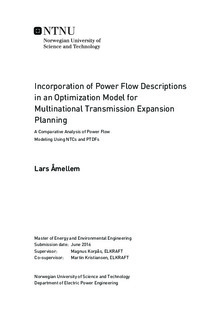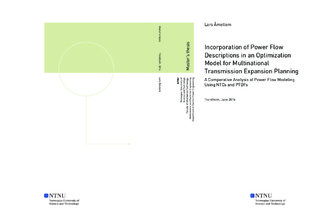| dc.description.abstract | Multinational transmission expansion planning (TEP), i.e. investments in cross-border electric power exchange capacity, is an important step towards achieving the ambitious decarbonization targets for the energy sector outlined by the European Commission. Power system flexibility and increased market integration are key elements for ensuring security of supply and avoiding curtailment of power production from renewable energy sources (RES), and is considered vital by the European Network of Transmission System Operators for Electricity (ENTSO-E) to maintain an efficient and secure pan-European power market. However, the most promising RES utilization strategy in Europe, harvesting intermittent solar- and wind energy, is characterized by large utilization potentials located far from onshore load centers, e.g. offshore wind in the North Sea, requiring long-distance transmission cables. To ensure optimal expansion of the interconnected European power grid, it is crucial to coordinate the connection of both future and existing offshore wind farms with the expansion of cross-border exchange capacity. However, offshore grid expansion may evoke unidentified distributional effects in the onshore AC grid, presenting operational system challenges. Hence, it is of great importance to develop decision-making tools that are suited for future market environments outlining the cost recovery of such investments, and to improve the power system modeling within these tools to enable TEP-models to account for distributional effects in the grid.
In light of multinational TEP, this thesis presents a comparative analysis quantifying the effects of expanding the system boundaries of an optimization model for grid investments, and subsequently incorporating different power flow modeling techniques. Considered techniques include a transportation model of the power network using net transfer capacities (NTCs), and a flow-based (FB) methodology utilizing power transfer distribution factors (PTDFs). Analyzes were conducted utilizing the generic TEP optimization model NetOp developed by SINTEF Energy, using mixed integer linear programming (MILP), to quantify the impact of applying the suggested model extensions to the North Seas offshore grid (NSOG). The analyzes were carried out under the four ENTSO-E 2030 Visions, outlining the future development of the European power system.
The results indicated a great need for expansion of the NSOG to reach EU s climate goals regardless of grid modeling technique and parameter forecast. All scenarios with both methodologies showed that the existing system is constrained by NSOG interconnectors of suboptimal capacity. Furthermore, the two approaches produced different optimal solutions, as expected from theory, with flow-based modeling resulting in greater power flows, stimulating higher investments in transmission capacity. This originates from the fact that FB takes all flows in the system into account, resulting in a more realistic representation of the grid, and differs from NTCs mainly because different laws and characteristics apply to commercial and physical exchange of electricity in an interconnected system. Additionally, there are indications of different utilization strategies for the major interconnectors of the North Seas with the two models, shifting Norway's role from provider of power and balancing services to transportation hub when moving from an NTC- to a PTDF representation. An overall assessment of the results reveals that an NTC-approach might yield suboptimal solutions to TEP, and that FB should be the preferred modeling technique where applicable. However, it is more computationally and analytically demanding.
To the author's knowledge, no similar studies regarding the impact of incorporating different power flow modeling techniques in a TEP-context have been conducted, particularly not for joint operational- and investment optimization of multinational offshore applications representing a mix of both HVAC- and HVDC grids. Two relevant contributions from this work will be improvement of AC grid representation in a MILP-model for multinational TEP, and quantification of investment- and computational effects of using different power flow modeling techniques. In addition, an indirect contribution of this work includes the possibility of enhanced evaluation of distributional effects of large offshore grid investments resulting from the improved AC grid representation. | |

